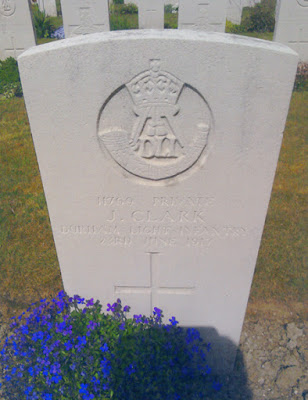So, the dust has finally settled on the Heaviside commemorations, and we have started talking about the next Victoria Cross events (for George McKean, in April 2018). As with the completion of every large project, there is something of a feeling of come down when everything that you have been working towards for months is at an end. The dust may have settled on our celebrations of an extraordinary man and his deeds but the Durham at War website enables us to preserve not only Michael Heaviside’s history but also the stories of those around him.
The Stanley News report of the parade for Michael Heaviside provided us with a fantastic basis for recreating the procession a hundred years later and was one of the sources that we used in the schools education sessions:
But it also hints at a number of other stories of the people of Craghead and Stanley, for example here are the words of Henry Greener from that report:
"He (the speaker) stood before them with not unmixed feelings, as they might guess; but one had got to weep with those who wept, and rejoice with those who rejoiced. His had been a time of weeping, and had he yielded to his own personal feelings he might not have been there; but he had set those feelings aside, and was glad of the privilege afforded him, in their name, of extending the most hearty and most cordial of welcomes to a man who had brought such honour to their village (Cheers)."
 |
| Harry Greener, Stanley News, 26 April 1917 |
Just three months before, Mr Greener’s son and namesake, Harry Greener, had been shot and killed in France. His younger son, John William Greener, had just been discharged from the army as being medically unfit in June 1917 after having been shot in the face and gassed. He died in 1919.
Harry Greener
http://www.durhamatwar.org.uk/story/12536/
Anthony Kuhlman
http://www.durhamatwar.org.uk/story/13412/
http://www.durhamatwar.org.uk/material/677/
Anthony Redhead Kuhlman (his son)
http://www.durhamatwar.org.uk/story/13437/
John William Greener
Another name that stands out from the newspaper report is that of Anthony Kuhlman:
"The children having sung “Rule Britannia,” Mr A Kuhlman moved a vote of thanks to all who had lent motor cars and assisted in other ways. There were many proud faces round him, and he could say that was the proudest day he had had in Craghead."
 |
| The people of Stanley turned out for the Heaviside parade in 2017 (Photo by Durham County Record Office) |
It is perhaps surprising to learn that Anthony Kuhlman was born in Germany and that he had resigned from Stanley Urban District Council because of “international differences”. In spite of this, he appears to have thrown himself into preparations for the town’s festivities and was struck by the cohesive effect that the parade had:
"That day to him, coming through Stanley, South Moor, and there, had been wonderful. He had never seen a day like it; it was an eye-opener that he never expected. It just required someone to set the ball rolling, and it would gather moss galore and take huge proportions. He never saw such a crowd. The committee were thoroughly and highly satisfied with the response to the efforts they had made. They had done a little good, but their efforts, if not seconded, would have fallen flat. Everyone had pulled together, so making work a pleasure. They could not expect to have many days like that, which was one of work and pleasure."
http://www.durhamatwar.org.uk/story/13412/
http://www.durhamatwar.org.uk/material/677/
Anthony Redhead Kuhlman (his son)
http://www.durhamatwar.org.uk/story/13437/














